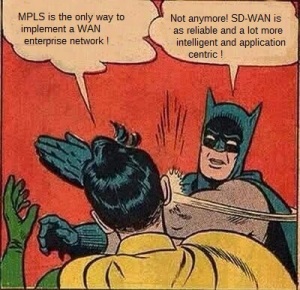Lets admit that most of us in the networking domain know as much about SD-WAN as an average 6th grader on fluid mechanics — which is to say pretty much nothing. We take it as something much grander and exotic than what it really is and are obviously surrounded by friends and well-wishers who wink conspiratorially that they “know it all” and consider themselves on an intellectual high ground to educate us on matters of this rich and riveting biological social interaction. Like most others in that tender and impressionable age, i did get swayed by what i heard and its only later that i was able to sort things out in my head, till it all became somewhat clear.
The proverbial clock’s wound backwards and i experience that feeling of deja-vu each time i read an article on SD-WAN that either extols its virtues or vilifies it as something that has always existed and is being speciously served on a platter dressed up as something that it is not. And like the big boys then, there are men who-know-it-all, who have already written SD-WAN off as something that has always existed and really presents nothing new here. Clearly, i disagree with that view.
I presume, perhaps a trifle rashly, that you are already aware of basic concepts of SDN and NFV (and this) and hence wouldnt waste any more oxygen explaining those.
So what really is the SD-WAN technology and the precise problem that its trying to solve?
SD-WAN is a way of architecting, designing and deploying enterprise WANs using commodity Internet connections in a manner that makes those “magically” appear as a private “MPLS-like” connection. Its the claim that it can appear “MPLS-like” that really peeves the regular-big-mpls-vendors-and-consultants. I will delve into the “MPLS-like” aspect a little later, so please hold on to your sabers till then. What makes the “magic” work is the control plane that implements and enforces the network access policies (VOIP is high priority/low latency/low jitter, big data sync medium priority and all else low priority, no VOIP via Afghanistan, etc) and the data plane that weaves an L2/L3 overlay on top of the existing consumer-grade Internet links (broadband links and in a few cases the LTE/4G connections).
The SD-WAN evangelists want to wean enterprises off their dedicated prohibitively priced private WAN connections (read MPLS circuits) with commodity enterprise broadband links. Philosophically, adding a new branch should just mean shipping a CPE device (perhaps in a virtualized form-factor) that auto-magically dials into a central controller when brought to life. Once thats done and the credentials verified, the branch should just come online (viola!) and should be visible to all the geo-separated branches. Contrast this with the provisioning time (can go as high as a year in some remote locations) and the complexity it takes to get a remote branch online today with MPLS and you will understand why most IT folks have ulcers and are perennially on anti-anxiety/depressant medicines. And btw we’ve not even begun talking about the expenses and long term contracts with the MPLS connections here!
Typically SD-WAN solutions have a central SDN controller which is really a cluster of x86 devices (servers, VMs, containers, take your pick) and hence has computing and analytical horsepower much more than a dedicated HW network device. The controller has complete visibility right from the source all the way till the destination and can constantly analyze traffic and can carve out optimal network paths for applications and individual flows based on the user and application policies. In the first mile the Internet links are either coalesced to form a fatter pipe or are used separately as dictated by the customer policies. The customer traffic is continuously finger-printed and is routed dynamically based on the real time network conditions.
Where most people go wrong is when they believe that SD-WAN solutions lose control over the traffic once it leaves the customer premises or the SD-WAN edge node. Bear in mind that there is nothing in the SD-WAN technology that prevents further control over how the traffic is routed and this could perhaps be one aspect differentiating one SD-WAN offering from the other. Since SD-WAN is an overlay technology you will not have control over each physical hop, but you can surely do something more nuanced given the application and end-to-end network visibility that exists with the controller.
Its “MPLS-like” in the sense that you can, in most cases, guarantee the available bandwidth and network up time. The central controller can monitor each overlay circuit for loss/jitter/delay and can take corrective actions when routing traffic. Patently enterprise broadband connections in certain geographies dont come with the same level of reliability as MPLS and it behooves upon us to ask ourselves if we need that level of reliability (given the cost that we pay for such connections). An enterprise can always hedge its risks by commissioning a few backup enterprise broadband connections for those rainy days when the primary is out cold. Alternatively, enterprises can go in for a hybrid approach where they maintain a low bandwidth MPLS connection for their mission-critical traffic and use the SD-WAN solution for everything else OR can implement a policy to revert to the MPLS connection when the Internet connections are not working satisfactorily. This can also provide a plausible transition strategy to the enterprises who may not be comfortable switching to SD-WANs given that the technology is still relatively new.
And do note that even MPLS connections go down, so its really not fair to say that SD-WAN solutions stand on tenuous grounds with regard to the reliability. Yes i concede that there are SLAs given with MPLS that just dont exist with regular Internet pipes. However, one could argue that you can get some bit of extra reliability by throwing in an additional Internet link (with a different provider?) thats only there as a standby. Also note that with service providers now giving fiber connections, the size and the quality of Internet links is only going to improve with time. A large site for instance can aggregate a 1Gbps Google Fiber and a 1Gbps Verizon FIOS connection and can retain a small MPLS connection as the standby. If the enterprise discovers that its MPLS connection is underutilized it can negotiate on pricing or can go with lower MPLS pipe and thereby save on its costs.
I recently read a blog which argued that enterprise broadband promising 350Mbps would mostly give only around 320Mbps on an average. Sure this might be true in a few geographies, but seriously, who cares? Given the cost difference between a broadband connection and an MPLS circuit i will gladly assume that i only had a 300Mbps connection and derive utmost pleasure any time it gives me anything more than that!
The central controller in the SD-WAN technologies amongst other things (analyzing traffic, links) can also continually learn about the customer network conditions and can predict when link qualities will deteriorate and can preemptively reroute traffic before the links start acting up. Given that the controller is monitoring paths end-to-end and is also monitoring and analyzing the traffic emanating from the branch sites there are insights that enterprises can draw that they could have never imagined when using traditional WAN architectures since in that world all connections are really only “dumb pipes”. SD-WAN changes all that — it changes how the enterprise connections and the applications running there are viewed. The WAN architecture is aligned to the application service requirements and its management is greatly simplified. You can implement complex network policies and let the SD-WAN infrastructure sweat on your behalf (HINT: intent driven networking).
So watch out before you disdainfully write off SD-WAN as a technology thats merely replacing your dumb MPLS pipes with the regular Internet connections, since i argue, it can really do a lot more than that. Perhaps a topic worth discussing some other day.





